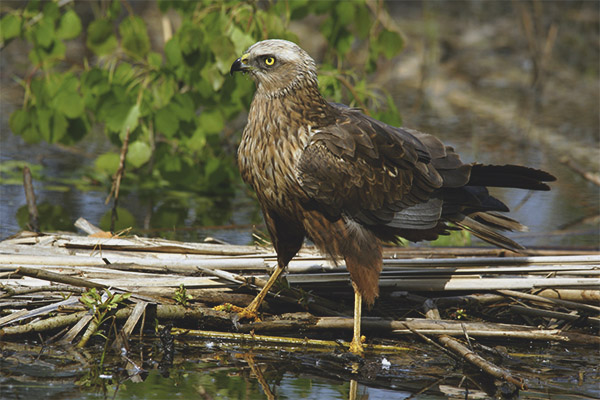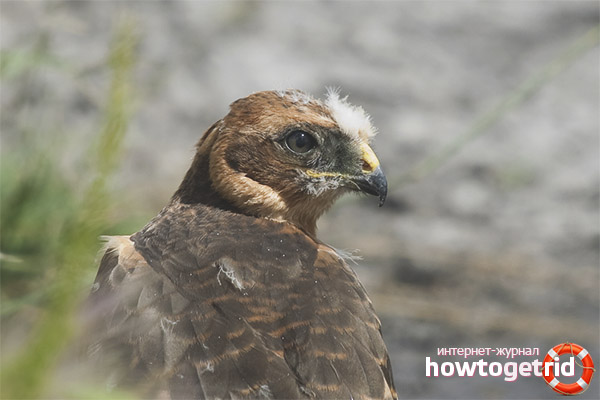The content of the article
Marsh harrier is an individual from the hawk family. Quite a large bird in terms of size, which is admirable when it is in the sky. The specimens of the represented breed group belong to predators, they have powerful wings that allow you to slaughter game. Lun prefers to settle in Europe. Today we look at everything that affects this breed, highlight the main aspects.
Spread
- It has already been mentioned that the birds of the family under discussion most often live in European countries. They are also met in Asia on the south side, in the UK, Eurasia and Africa. These birds prefer to be in the marshland.
- They need vegetation and small thickets at the edges, as well as a small water source. Birds are in reed thickets, which coincide in shade with the color of plumage.This allows individuals to hunt high-quality, and also to hide from prying eyes.
- If we take into account the fact that the harrier is perfectly camouflaged and hiding from opponents, then it becomes unclear for what reasons the population of these birds is rapidly declining. Typically, this phenomenon is associated with drought, lack of food and pollution.
- Of course, it does not do without the human factor. Due to the development of hunting, the number of marsh representatives becomes smaller. Today, a bird with unique characteristics and external data can be admired only in a zoo.
Description and lifestyle
- These individuals are distinguished by impressive overall features. They are often found in the airspace of European countries. Experienced people have long learned to distinguish the morass from other representatives. According to the dimensional features of the individual grow to 50 cm.
- When a bird is in the sky, it hovers leisurely and measured. For this reason, people love to watch the moons. The bird chooses the moment when it is necessary to stop for rest.Thus, she can flap her wings at one moment, and in the other she will stop and hang on the spot. Further, the individual slowly and gracefully descends, hovering over the soil.
- Lun in the process of piloting taxis with its elongated and rigid tail. When a bird spreads its wings and makes them flap, it acquires a stately silhouette in the form of a tick. When the harrier sees the prey, it remains in the reed thickets and waits, after which it rapidly attacks. Also, individuals eat the aquatic environment. They grab them with claws and pull them out. Then proceed to the meal.
- External data in terms of color depends not only on gender or age category. These birds vary depending on the period of the year, they can change the coloring of feathers several times. Of course, gender differences are also present.
- For example, individuals of female affiliation are pigmented with brownish tones with beige tints in the head, wings and neck areas. Male representatives look stricter, they are painted in gray, whitish, black.
- The moon has an interesting feature associated with a hearing aid.There are feathers in the ears, which act as a navigator, that is, they capture sound waves and direct the bird. This quality is very convenient in terms of hunting among the reeds.
- For wintering individuals go to Africa, but if the climatic conditions in the place of residence are mild, then the bird does not need to fly away. Moreover, the loonies do not like to leave their native spaces. The saddle is closer to them than the lifestyle of a nomad.
Nutrition
- It is worth noting an amazing fact, representatives of this species feed on a variety of foods. Yet most often such individuals prefer mice and mammals. Mostly lun is not picky about food. Often he feeds even waterfowl. He can also eat small fish and frogs.
- When presented individuals hover at high altitude, they are able to see with their keen eyes a gopher in an open area. In addition, the birds in question often hunt rabbits. During nesting and breeding, adult individuals feed their chicks with small birds.
- Males are closely watching their own territory. They patrol her constantly.In addition, the individual will never miss the moment to seize the gaping prey. The loonies swoop at a low altitude and seize everyone who gets in their way. The victim dies in flight. After that, the bird divides it into several portions.
- In addition, the presented individuals can be good fishermen. Loonies can look out for fish and at one moment grab it with long claws. In addition, it was noted more than once that the loonies attacked even the adult forty. We should also mention that the diet will directly depend on the habitat of individuals.
- The loonies living in the southwest of Turkmenistan mostly feed on waterfowl. Also, the basis of their food includes small rodents and lizards. The individuals living in Holland most often hunt on rabbits. At this time, young Harrier feeds on coot chicks.
Characteristics
- It is worth noting that the mating period in the individuals under consideration is rather unusual. A pair starts circling in the sky at high altitude. In this case, both birds excrete various tricks and figures. Such behavior is simply impossible to describe.
- During mating games, individuals spend a long time in the air.They show each other their skills and dexterity. As a result, the males conquer their chosen ones, thus forming a pair for many years.
The presented individuals differ from their relatives by unusual mating behavior. Construction of the nest birds are engaged in jointly. While incubating, the female remains in the nest. At this time, the male goes in search of food.
Video: Marsh Harrier (Circus aeruginosus)












To send